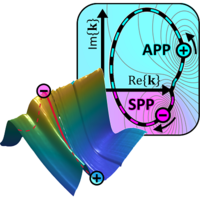当前位置:
X-MOL 学术
›
Phys. Rev. X
›
论文详情
Our official English website, www.x-mol.net, welcomes your
feedback! (Note: you will need to create a separate account there.)
Nonmodal Plasmonics: Controlling the Forced Optical Response of Nanostructures
Physical Review X ( IF 11.6 ) Pub Date : 2020-03-25 , DOI: 10.1103/physrevx.10.011071 Gilad Rosenblatt , Boris Simkhovich , Guy Bartal , Meir Orenstein
Physical Review X ( IF 11.6 ) Pub Date : 2020-03-25 , DOI: 10.1103/physrevx.10.011071 Gilad Rosenblatt , Boris Simkhovich , Guy Bartal , Meir Orenstein

|
The operation of numerous physical systems and devices relies on concentrating their state space around a few carefully engineered eigenstates governing the dynamics. In photonics, these discrete degrees of freedom are typically the resonant modes of a structure. However, whenever a light source drives the structure, a continuum of additional nonmodal states generates its forced response, undermining its underlying physics and hindering control through discretization. Dealing with this nonmodal continuum poses a challenge to the design of nanophotonic systems aiming to combine compact sources and nanostructures into unified functional platforms. Here, we present a route to control forced nanostructures by engineering a discrete set of nonmodal degrees of freedom, originating from joint nanostructure-source antiresonances. We experimentally demonstrate that the forced response of ultrathin gold films is shaped by pairs of resonant-antiresonant plasmons, exhibiting joint creation and annihilation in momentum-energy space. Tuning their excitation, we show that 10 nm films can appear “black”: exhibiting strong spectroangular wideband absorption.
中文翻译:

非峰等离子:控制纳米结构的强迫光学响应
众多物理系统和设备的运行依赖于将状态空间集中在一些精心设计的动态特性上,从而控制动力学。在光子学中,这些离散的自由度通常是结构的共振模式。但是,每当光源驱动结构时,连续的其他非模态状态就会产生强制响应,从而破坏其基本物理特性并阻碍离散化的控制。处理这种非模态连续体对纳米光子系统的设计提出了挑战,该系统旨在将紧凑的光源和纳米结构结合到统一的功能平台中。在这里,我们提出了一种通过设计离散的非模态自由度集来控制强迫纳米结构的途径,该离散度源自联合的纳米结构-源反共振。我们实验证明超薄金膜的强迫响应是由成对的共振-反共振等离子体激元形成的,在动量-能量空间中表现出联合的创造和an灭。调整它们的激发,我们显示10 nm的薄膜可能会出现“黑色”:表现出强的光谱宽带吸收。
更新日期:2020-03-25
中文翻译:

非峰等离子:控制纳米结构的强迫光学响应
众多物理系统和设备的运行依赖于将状态空间集中在一些精心设计的动态特性上,从而控制动力学。在光子学中,这些离散的自由度通常是结构的共振模式。但是,每当光源驱动结构时,连续的其他非模态状态就会产生强制响应,从而破坏其基本物理特性并阻碍离散化的控制。处理这种非模态连续体对纳米光子系统的设计提出了挑战,该系统旨在将紧凑的光源和纳米结构结合到统一的功能平台中。在这里,我们提出了一种通过设计离散的非模态自由度集来控制强迫纳米结构的途径,该离散度源自联合的纳米结构-源反共振。我们实验证明超薄金膜的强迫响应是由成对的共振-反共振等离子体激元形成的,在动量-能量空间中表现出联合的创造和an灭。调整它们的激发,我们显示10 nm的薄膜可能会出现“黑色”:表现出强的光谱宽带吸收。











































 京公网安备 11010802027423号
京公网安备 11010802027423号